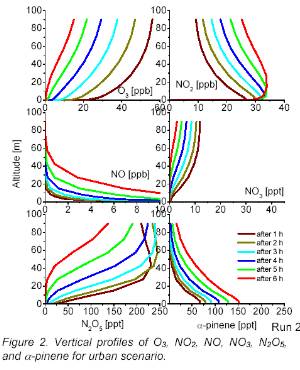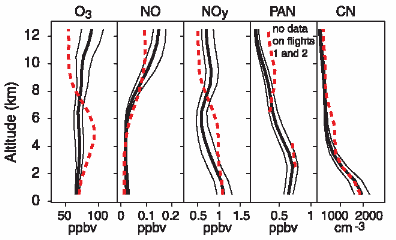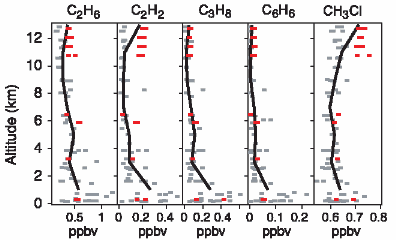 > English > Climate Encyclopaedia > Lower Atmosphere > more > 4. Gases in the atmosphere > - Distribution & concentration (2)
> English > Climate Encyclopaedia > Lower Atmosphere > more > 4. Gases in the atmosphere > - Distribution & concentration (2)
|
Lower AtmosphereRead more |
Distribution & concentration (2)It's impossible to give average atmospheric concentrations for the less stable compounds in the air. Their concentrations depend strongly on the chemical conditions in the air at a particular time.
|
|
Measured compounds: CH4 = methane
|
|
O3 = ozone
|
|
C2H6 = ethane
|
Gases in the troposphereIts very difficult to give an overview of the concentrations of trace gases in the troposphere. The same compound can be present at extremely low concentrations, for example, over the ocean and at very high concentrations in the urban environment. There are also many different gases which play an important role in the troposphere. So the following table just gives a few examples of the average mixing ratios near the ground for commonly measured compounds.
|
|
Overview of important gases in the free atmosphere:
*The concentrations of gases with a star have increased as a result of human activity and are relatively well mixed over the globe. The percent values of the main components of air are given for dry air. Data from 2005-2007.
|
Mixing ratios, concentrations and different units:Amounts of gases are often given in different units: concentrations: molecules cm-2 or µmol m-3 Mixing ratios are often more helpful for scientists. When air rises, it expands in volume and, as a result, the concentration of the gas changes. The mixing ratio (relative proportion of the gas to the total number of air molecules), however, remains the same. Conversion from one unit to the other depends on the pressure (= the altitude) and the molecular weight of the compound. If we do the calculation for the surface of the Earth at a normal pressure of about 1 bar we can express the total molecules per volume of air in the following way: 1 mol = 22.4 L = 6x1023 molecules => A rough estimate: So the mixing ratio is about 2.7 x 1016 / 2.7 x 1025 = 10-9 = 1 ppb Since ozone has a similar molecular weight, M(O3) = 48 g mol-1, we can also say roughly that; This calculation is valid only for surface of the Earth where we live. So for ozone smog events in urban areas we can now calculate:
|
|
Related pages There is more about concentrations and mixing ratios at:
|
About this page:author: Dr. Elmar Uherek - Max Planck Institute for Chemistry Mainz
|




